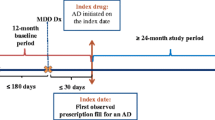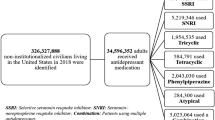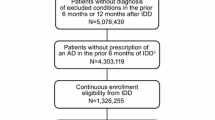Abstract
Purpose
Patients’ nonadherence to antidepressant treatment hampers cost and efficacy of depression-specific treatment. However, previous studies have failed to find consistent findings in economic effect on nonadherence and also failed to reach consensus in how to measure nonadherence to treatment. The study attempts to investigate income effect on nonadherence to selective serotonin reuptake inhibitors (SSRIs) treatment with clear definitions of nonadherence: self discontinuation of SSRIs (nonpersistence) and under-dose of SSRIs (noncompliance).
Methods
The study extracted data from the National Comorbidity Survey-Replication (NCS-R). The study sample (n = 280) includes adults between the ages of 18 and 64 who were diagnosed with Diagnostic Statistics Manual IV Major Depressive Episode (MDE) at some point during their lifetime and medicated with SSRIs in the past 12 months.
Results
Just above poverty level of family income and no health insurance increased the risk of medication nonpersistence in SSRIs treatment. The study findings confirmed that African Americans were at higher risk of medication noncompliance than Whites (odds ratio, 4.53) and MDE comorbidity was positively associated with medication noncompliance (odds ratio, 4.25).
Conclusions
Low income level, combined with health insurance status, and race/ethnicity, predict nonadherence to antidepressant treatment. The study findings would help physicians and hospitals developing interventional strategies and programs to increase patients’ adherence rates in antidepressant treatment.
Similar content being viewed by others
References
Olfson M, Marcus SC, Druss B, Elinson L, Tanielian T, Pincus HA (2002) National trends in the outpatient treatment of depression. JAMA 287(2):203–209. doi:10.1001/jama.287.2.203
Mojtabai R, Olfson M (2010) National trends in psychotropic medication polypharmacy in office-based psychiatry. Arch Gen Psychiatry 67(1):26–36. doi:10.1001/archgenpsychiatry.2009.175
Olfson M, Marcus SC (2009) National patterns in antidepressant medication treatment. Arch Gen Psychiatry 66(8):848–856. doi:10.1001/archgenpsychiatry.2009.81
Anderson IM (2000) Selective serotonin reuptake inhibitors versus tricyclic antidepressants: a meta-analysis of efficacy and tolerability. J Affect Disord 58(1):19–36. doi:10.1016/s0165-0327(99)00092-0
Montgomery SA, Kasper S (1995) Comparison of compliance between serotonin reuptake inhibitors and tricyclic antidepressants: a meta-analysis. Int Clin Psychopharmacol 9(Suppl 4):33–40
Beasley CM, Koke SC, Nilsson ME, Gonzales JS (2000) Adverse events and treatment discontinuations in clinical trials of fluoxetine in major depressive disorder: an updated meta-analysis. Clin Ther 22(11):1319–1330. doi:10.1016/s0149-2918(00)83028-3
Keller MB, Hirschfeld RMA, Demyttenaere K, Baldwin DS (2002) Optimizing outcomes in depression: focus on antidepressant compliance. Int Clin Psychopharmacol 17(6):265–271
Chakraborty K, Avasthi A, Kumar S, Grover S (2009) Attitudes and beliefs of patients of first episode depression towards antidepressants and their adherence to treatment. Soc Psychiatry Psychiatr Epidemiol 44(6):482–488
Demyttenaere K, Haddad P (2000) Compliance with antidepressant therapy and antidepressant discontinuation symptoms. Acta Psychiatr Scand 101:50–56. doi:10.1111/j.1600-0447.2000.tb10948.x
Masand PS (2003) Tolerability and adherence issues in antidepressant therapy. Clin Ther 25(8):2289–2304
DiMatteo MR, Lepper HS, Croghan TW (2000) Depression is a risk factor for noncompliance with medical treatment: meta-analysis of the effects of anxiety and depression on patient adherence. Arch Intern Med 160:2101–2107
Melfi CA, Chawla AJ, Croghan TW, Hanna MP, Kennedy S, Sredl K (1998) The effects of adherence to antidepressant treatment guidelines on relapse and recurrence of depression. Arch Gen Psychiatry 55(12):1128–1132. doi:10.1001/archpsyc.55.12.1128
Melartin TK, Rytsälä HJ, Leskelä US, Lestelä-Mielonen PS, Sokero TP, Isometsä ET (2005) Continuity is the main challenge in treating major depressive disorder in psychiatric care. J Clin Psychiatry 66:220–227
Cantrell CR, Eaddy MT, Shah MB, Regan TS, Sokol MC (2006) Methods for evaluating patient adherence to antidepressant therapy: a real-world comparison of adherence and economic outcomes. Med Care 44(4):300–303
Tournier M, Moride Y, Crott R, Galbaud du Fort G, Ducruet T (2009) Economic impact of non-persistence to antidepressant therapy in the quebec community-dwelling elderly population. J Affect Disord 115(1–2):160–166. doi:10.1016/j.jad.2008.07.004
Sawada N, Uchida H, Suzuki T, Watanabe K, Kikuchi T, Handa T, Kashima H (2009) Persistence and compliance to antidepressant treatment in patients with depression: a chart review. BMC Psychiatry 9:38. doi:10.1186/1471-244X-9-38
Cramer JA, Roy A, Burrell A, Fairchild CJ, Fuldeore MJ, Ollendorf DA, Wong PK (2008) Medication compliance and persistence: terminology and definitions. Value Health 11(1):44–47. doi:10.1111/j.1524-4733.2007.00213.x
Lingam R, Scott J (2002) Treatment non-adherence in affective disorders. Acta Psychiatr Scand 105(3):164–172. doi:10.1034/j.1600-0447.2002.1r084.x
Mitchell AJ, Selmes T (2007) Why don’t patients take their medicine? Reasons and solutions in psychiatry. Adv Psychiatr Treat 13(5):336–346. doi:10.1192/apt.bp.106.003194
McHorney CA, Spain VC, Alexander CM, Simmons J (2009) Validity of the adherence estimator in the prediction of 9-month persistence with medications prescribed for chronic diseases: a prospective analysis of data from pharmacy claims. Clin Ther 31(11):2584–2607. doi:10.1016/j.clinthera.2009.11.030
Claesson S, Morrison A, Wertheimer AI, Berger ML (1999) Compliance with prescribed drugs: challenges for the elderly population. Pharm World Sci 21(6):256–259
Peterson AM, Nau DP, Cramer JA, Benner J, Gwadry-Sridhar F, Nichol M (2007) A checklist for medication compliance and persistence studies using retrospective databases. Value Health 10(1):3–12. doi:10.1111/j.1524-4733.2006.00139.x
Osterberg L, Blaschke T (2005) Adherence to medication. N Engl J Med 353(5):487–497. doi:10.1056/NEJMra050100
Martin BC, Wiley-Exley EK, Richards S, Domino ME, Carey TS, Sleath BL (2009) Contrasting measures of adherence with simple drug use, medication switching, and therapeutic duplication. Ann Pharmacother 43(1):36–44. doi:10.1345/aph.1K671
Hess LM, Raebel MA, Conner DA, Malone DC (2006) Measurement of adherence in pharmacy administrative databases: a proposal for standard definitions and preferred measures. Ann Pharmacother 40(7):1280–1288. doi:10.1345/aph.1H018
Demyttenaere K (1998) Noncompliance with antidepressants: who’s to blame? Int Clin Psychopharmacol 13(Suppl. 2):S19–S25
Bentall RP, Powell P, Nye FJ, Edwards RHT (2002) Predictors of response to treatment for chronic fatigue syndrome. British J Psychiatry 181(3):248–252. doi:10.1192/bjp.181.3.248
Sirey JA, Bruce ML, Alexopoulos GS, Perlick DA, Raue P, Friedman SJ, Meyers BS (2001) Perceived stigma as a predictor of treatment discontinuation in young and older outpatients with depression. Am J Psychiatry 158(3):479–481. doi:10.1176/appi.ajp.158.3.479
Demyttenaere K, Enzlin P, Dewé W, Boulanger B, De Bie J, De Troyer W, Mesters P (2001) Compliance with antidepressants in a primary care setting, 1: beyond lack of efficacy and adverse events. J Clin Psychiatry 62(Suppl 22):30–33
Bosworth HB, Voils CI, Potter GG, Steffens DC (2008) The effects of antidepressant medication adherence as well as psychosocial and clinical factors on depression outcome among older adults. Int J Geriatr Psychiatry 23(2):129–134. doi:10.1002/gps.1852
Sawamura K, Ito H, Koyama A, Tajima M, Higuchi T (2010) The effect of an educational leaflet on depressive patients’ attitudes toward treatment. Psychiatry Res 177(1–2):184–187
Shelton C (2009) Factors impacting the selection of antidepressant treatment in patients with major depressive disorder at risk for nonadherence. CNS Spectr 14(suppl 12):15–19
Rush AJ (2007) Star*d: what have we learned? Am J Psychiatry 164(2):201–204. doi:10.1176/appi.ajp.164.2.201
Isacson D, Bingefors K (2002) Attitudes towards drugs—a survey in the general population. Pharm World Sci 24(3):104–110. doi:10.1023/a:1016127320051
van Ryn M, Burke J (2000) The effect of patient race and socio-economic status on physicians’ perceptions of patients. Soc Sci Med 50(6):813–828. doi:10.1016/s0277-9536(99)00338-x
Woo JKH, Ghorayeb SH, Lee CK, Sangha H, Richter S (2004) Effect of patient socioeconomic status on perceptions of first- and second-year medical students. CMAJ 170(13):1915–1919. doi:10.1503/cmaj.1031474
Dobscha S, Winterbottom L, Snodgrass L (2007) Reducing drug costs at a veterans affairs hospital by increasing market-share of generic fluoxetine. Community Ment Health J 43(1):75–84
Fischer JF, Mowers RM, Ormerod DJ, Burris ES (2001) Driving market share in an integrated health system without therapeutic interchange. J Manag Care Pharm 7(4):283–286
Wang PS, Lane M, Olfson M, Pincus HA, Wells KB, Kessler RC (2005) Twelve-month use of mental health services in the United States: results from the national comorbidity survey replication. Arch Gen Psychiatry 62(6):624–629
Kessler RC, Merikangas KR, Wang PS (2007) Prevalence, comorbidity, and service utilization for mood disorders in the united states at the beginning of the twenty-first century. Annu Rev Clin Psycho 3(1):137–158. doi:10.1146/annurev.clinpsy.3.022806.091444
Burra TA, Chen E, McIntyre RS, Grace SL, Blackmore ER, Stewart DE (2007) Predictors of self-reported antidepressant adherence. Behav Med 32(4):127–134
Brook OH, van Hout HPJ, Stalman WAB, de Haan M (2006) Nontricyclic antidepressants: predictors of nonadherence. J Clin Psychopharmacol 26(6):643–647
Proctor BD, Dalaker J (2002) Current population reports. In: Poverty in the united states: 2001. US Government Printing Office, Washington, DC
Kessler RC, Demler O, Frank RG, Olfson M, Pincus HA, Walters EE, Wang P, Wells KB, Zaslavsky AM (2005) Prevalence and treatment of mental disorders, 1990 to 2003. N Engl J Med 352(24):2515–2523
Kessler RC, Berglund P, Demler O, Jin R, Koretz D, Merikangas KR, Rush AJ, Walters EE, Wang PS (2003) The epidemiology of major depressive disorder: results from the national comorbidity survey replication (ncs-r). JAMA 289(23):3095–3105. doi:10.1001/jama.289.23.3095
American Psychiatric Association (2000) Practice guideline for the treatment of patients with major depression. American Psychiatric Association, Arlington
Robinson RL, Long SR, Chang S, Able S, Baser O, Obenchain RL, Swindle RW (2006) Higher costs and therapeutic factors associated with adherence to ncqa hedis antidepressant medication management measures: analysis of administrative claims. J Manag Care Pharmacy 12(1):43–54
Rush AJ, Trivedi MH, Wisniewski SR, Stewart JW, Nierenberg AA, Thase ME, Ritz L, Biggs MM, Warden D, Luther JF, Shores-Wilson K, Niederehe G, Fava M (2006) Bupropion-sr, sertraline, or venlafaxine-xr after failure of ssris for depression. N Engl J Med 354(12):1231–1242. doi:10.1056/NEJMoa052963
Kocsis JH, Schatzberg A, Rush AJ, Klein DN, Howland R, Gniwesch L, Davis SM, Harrison W (2002) Psychosocial outcomes following long-term, double-blind treatment of chronic depression with sertraline vs placebo. Arch Gen Psychiatry 59(8):723–728. doi:10.1001/archpsyc.59.8.723
Keller MB, Kocsis JH, Thase ME, Gelenberg AJ, Rush AJ, Koran L, Schatzberg A, Russell J, Hirschfeld R, Klein D, McCullough JP, Fawcett JA, Kornstein S, LaVange L, Harrison W, For the Sertraline Chronic Depression Study Group (1998) Maintenance phase efficacy of sertraline for chronic depression: a randomized controlled trial. JAMA 280(19):1665–1672. doi:10.1001/jama.280.19.1665
Terra JL, Montgomery SA (1998) Fluvoxamine prevents recurrence of depression: results of a long-term, double-blind, placebo-controlled study. Int Clin Psychopharmacol 13(2):55–62
RTI International-University of North Carolina Evidence-based Practice Center (2007) Comparative effectiveness of second-generation antidepressants in the pharmacologic treatment of adult depression: comparative effectiveness review. Agency for Healthcare Research and Quality, Rockville
Kessler RC, Berglund P, Demler O, Jin R, Merikangas KR, Walters EE (2005) Lifetime prevalence and age-of-onset distributions of dsm-iv disorders in the national comorbidity survey replication. Arch Gen Psychiatry 62(6):593–602. doi:10.1001/archpsyc.62.6.593
Fleck DE, Hendricks WL, DelBello MP, Strakowski SM (2002) Differential prescription of maintenance antipsychotics to African American and white patients with new-onset bipolar disorder. J Clin Psychiatry 63(8):658–664
Diaz E, Woods SW, Rosenheck RA (2005) Effects of ethnicity on psychotropic medications adherence. Community Ment Health J 41(5):521–537
Wu C-H, Erickson SR, Piette JD, Balkrishnan R. The association of race, comorbid anxiety, and antidepressant adherence among medicaid enrollees with major depressive disorder. ResSoc Adm Pharmacy. doi:10.1016/j.sapharm.2011.04.002
Armstrong K, Ravenell KL, McMurphy S, Putt M (2007) Racial/ethnic differences in physician distrust in the United States. Am J Public Health 97(7):1283–1289. doi:10.2105/ajph.2005.080762
Boulware LE, Cooper LA, Ratner LE, LaVeist TA, Powe NR (2003) Race and trust in the health care system. Public Health Rep 118(4):358–365
Gamble VN (1997) Under the shadow of Tuskegee: African Americans and health care. Am J Public Health 87(11):1773–1778. doi:10.2105/ajph.87.11.1773
Chakraborty A, King M, Leavey G, McKenzie K (2011) Perceived racism, medication adherence, and hospital admission in african-caribbean patients with psychosis in the United Kingdom. Soc Psychiatry Psychiatr Epidemiol 46(9):915–923. doi:10.1007/s00127-010-0261-8
Fleck DE, Keck PE, Corey KB, Strakowski SM (2005) Factors associated with medication adherence in African American and white patients with bipolar disorder. J Clin Psychiatry 63(8):658–664
Papakostas GI (2009) Managing partial response or nonresponse: switching, augmentation, and combination strategies for major depressive disorder. J Clin Psychiatry 70(Suppl 6):16–25
Thacher JA, Morey E, Craighead WE (2005) Using patient characteristics and attitudinal data to identify depression treatment preference groups: a latent-class model. Depression Anxiety 21(2):47–54
Olfson M, Mojtabai R, Sampson NA, Hwang I, Druss B, Wang PS, Wells KB, Pincus HA, Kessler RC (2009) Dropout from outpatient mental health care in the United States. Psychiatr Serv 60(7):898–907. doi:10.1176/appi.ps.60.7.898
Bull SA, Hu XH, Hunkeler EM, Lee JY, Ming EE, Markson LE, Fireman B (2002) Discontinuation of use and switching of antidepressants: influence of patient–physician communication. JAMA 288(11):1403–1409. doi:10.1001/jama.288.11.1403
Masand PS, Roca M, Turner MS, Kane JM (2009) Partial adherence to antipsychotic medication impacts the course of illness in patients with schizophrenia: a review. Prim Care Companion J Clin Psychiatry 11(4):147–154
McLaughlin T, Hogue SL, Stang PE (2007) Once-daily bupropion associated with improved patient adherence compared with twice-daily bupropion in treatment of depression. American J Therapeutics 14 (2):221-225 210.1097/1001.mjt.0000208273.0000280496.0000208273f
Croghan TW, Melfi CA, Dobrez DG, Kniesner TJ (1999) Effect of mental health specialty care on antidepressant length of therapy. Medical Care 37(Suppl 4):AS20–AS23
Van Voorhees BW, Cooper LA, Rost KM, Nutting P, Rubenstein LV, Meredith L, Wang NY, Ford DE (2003) Primary care patients with depression are less accepting of treatment than those seen by mental health specialists. J Gen Intern Med 18(12):991–1000
Olfson M, Marcus SC, Tedeschi M, Wan GJ (2006) Continuity of antidepressant treatment for adults with depression in the United States. Am J Psychiatry 163(1):101–108. doi:10.1176/appi.ajp.163.1.101
Mcmanus P, Mant A, Mitchell P, Britt H, Dudley J (2003) Use of antidepressants by general practitioners and psychiatrists in Australia. Aust N Z J Psychiatry 37(2):184–189. doi:10.1046/j.1440-1614.2003.01132.x
Tamburrino MB, Nagel RW, Chahal MK, Lynch DJ (2009) Antidepressant medication adherence: a study of primary care patients. J Clin Psychiatry 11(5):205–211
Demyttenaere K, Enzlin P, Dewé W, Boulanger B, De Bie J, De Troyer W, Mesters P (2001) Compliance with antidepressants in a primary care setting, 2: influence of gender and types of impairment. J Clin Psychiatry 62(Suppl 22):34–37
Shigemura J, Ogawa T, Yoshino A, Sato Y, Nomura S (2010) Predictors of antidepressant adherence: results of a Japanese internet-based survey. Psychiatry Clin Neurosci 64:179–186
Lee M-S, Lee H-Y, Kang S-G, Yang J, Ahn H, Rhee M, Ko Y-H, Joe S-H, Jung I-K, Kim S-H (2010) Variables influencing antidepressant medication adherence for treating outpatients with depressive disorders. J Affect Disord 123(1–3):216–221
Kobak KA, Taylor L, Katzelnick DJ, Olson N, Clagnaz P, Henk HJ (2002) Antidepressant medication management and health plan employer data information set (hedis) criteria: reasons for nonadherence. J Clin Psychiatry 63(8):727–732
Lin EH, Von Korff M, Katon W, Bush T, Simon GE, Walker E, Robinson P (1995) The role of the primary care physician in patients’ adherence to antidepressant therapy. Med Care 33(1):67–74
van Geffen E, van der Wal S, van Hulten R, de Groot M, Egberts A, Heerdink E (2007) Evaluation of patients’ experiences with antidepressants reported by means of a medicine reporting system. Eur J Clin Pharmacol 63(12):1193–1199
Demyttenaere K (1997) Compliance during treatment with antidepressants. J Affect Disord 43(1):27–39
Bulloch A, Patten S (2010) Non-adherence with psychotropic medications in the general population. Soc Psychiatry Psychiatr Epidemiol 45(1):47–56. doi:10.1007/s00127-009-0041-5
Rickles NM, Svarstad BL (2007) Relationships between multiple self-reported nonadherence measures and pharmacy records. Res Soc Adm Pharmacy 3(4):363–377. doi:10.1016/j.sapharm.2006.11.001
Author information
Authors and Affiliations
Corresponding author
Appendix
Appendix
Rights and permissions
About this article
Cite this article
Jeon-Slaughter, H. Economic factors in of patients’ nonadherence to antidepressant treatment. Soc Psychiatry Psychiatr Epidemiol 47, 1985–1998 (2012). https://doi.org/10.1007/s00127-012-0497-6
Received:
Accepted:
Published:
Issue Date:
DOI: https://doi.org/10.1007/s00127-012-0497-6




